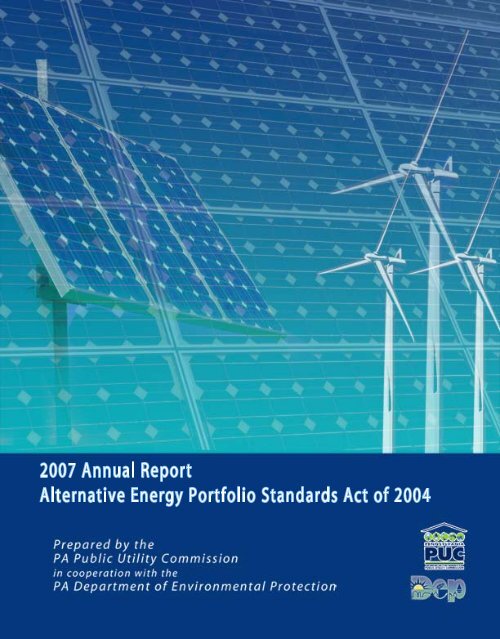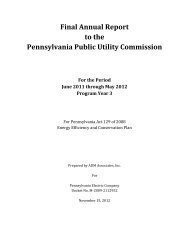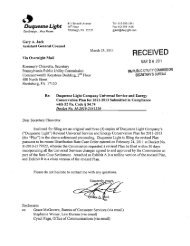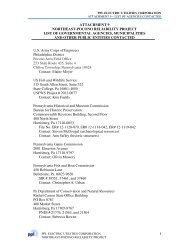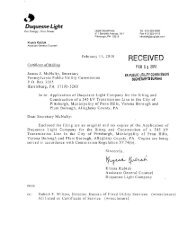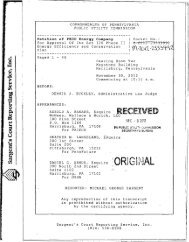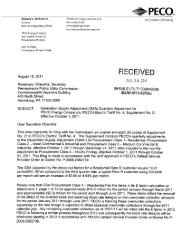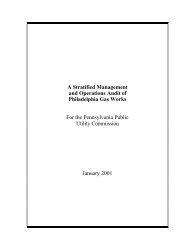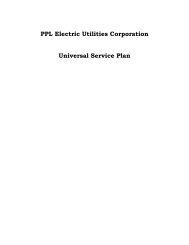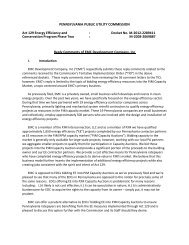2007 Annual Report - Pennsylvania Public Utility Commission
2007 Annual Report - Pennsylvania Public Utility Commission
2007 Annual Report - Pennsylvania Public Utility Commission
You also want an ePaper? Increase the reach of your titles
YUMPU automatically turns print PDFs into web optimized ePapers that Google loves.
<strong>2007</strong><strong>Annual</strong><strong>Report</strong><br />
AlternativeEnergyPortfolioStandardsActof2004
<strong>2007</strong> <strong>Annual</strong> <strong>Report</strong><br />
Alternative Energy Portfolio Standards Act of 2004<br />
Published by the<br />
<strong>Pennsylvania</strong> <strong>Public</strong> <strong>Utility</strong> <strong>Commission</strong><br />
P.O. Box 3265, Harrisburg, PA 17105-3265<br />
www.puc.state.pa.us<br />
Wendell F. Holland, Chairman<br />
James H. Cawley, Vice Chairman<br />
Kim Pizzingrilli, <strong>Commission</strong>er<br />
Tyrone J. Christy, <strong>Commission</strong>er<br />
Prepared by the<br />
PUC Bureau of Conservation, Economics and Energy Planning<br />
Wayne Williams, Ph.D., Director<br />
In cooperation with the<br />
<strong>Pennsylvania</strong> Department of Environmental Protection<br />
Kathleen McGinty, Secretary<br />
www.dep.state.pa.us<br />
May 2008
Table of Contents<br />
Executive Summary...........................................................................................................................4<br />
Compliance Summary by Energy Source and Electric Distribution Company Service Territory............ 6<br />
Future Compliance by Remaining Electric Distribution Companies.....................................................7<br />
Alternative Energy Credits Registry.................................................................................................. 7<br />
AEPS Generators Certified...............................................................................................................8<br />
AEPS Certificates Created................................................................................................................8<br />
AEPS Credit Program Administrator.................................................................................................8<br />
Net Metering and Interconnection Implementation............................................................................9<br />
<strong>Pennsylvania</strong>’s Alternative Energy Portfolio Standards Marketplace.................................................11<br />
Estimated Costs of Renewable Resources in <strong>Pennsylvania</strong>................................................................15<br />
Recommendations for Program Improvements..................................................................................16<br />
Background.................................................................................................................................... 17<br />
Chronology of Events...................................................................................................................... 19<br />
Appendix A – List of Alternative Energy Portfolio Standards Generators Certified...........................20<br />
Appendix B – Discussion of Cost Estimating Methodology................................................................ 28<br />
PUC Orders.....................................................................................................................................33
Executive Summary<br />
The electric distribution companies (EDCs) and electric generation suppliers (EGSs) subject<br />
to <strong>2007</strong> compliance standards under the Alternative Energy Portfolio Standards Act (AEPS) of 2004<br />
purchased the requisite number of alternative energy credits (AECs) to meet their obligations for the<br />
first reporting period. 1<br />
<strong>Pennsylvania</strong> Power Company (Penn Power) and UGI Utilities, Inc. - Electric, were required<br />
to comply with the law beginning in <strong>2007</strong>. In addition, five EGSs that are active in the Penn Power<br />
territory recorded sales for this reporting period and therefore had compliance obligations as well.<br />
They include Constellation New Energy, Dominion Retail, Sempra, FirstEnergy Solutions and<br />
Strategic Energy.<br />
Between Feb. 28, <strong>2007</strong>, and May 31, <strong>2007</strong>, the companies sold a total of 1,452,807 megawatt<br />
hours (MWHs) of electricity and purchased 82,877 AECs to meet their obligations. 2<br />
Overall, the AEPS law requires EDCs and EGSs to supply 18.5 percent of electricity using<br />
alternative energy resources by 2021. The percentage of Tier I, Tier II and photovoltaic resources that<br />
must be included in sales to retail customers gradually increases over this period. 3 By Jan. 1, 2008,<br />
the renewable resource requirement is estimated to be 1,215,822 MWHs, representing approximately<br />
0.75 percent of the Commonwealth’s annual energy demand. By Jan. 1, 2021, AEPS will provide an<br />
estimated 36,639,425 MWHs, or 18.5 percent of <strong>Pennsylvania</strong>’s annual electric requirements.<br />
AEPS compliance is verified and tracked through an alternative energy credits program, in<br />
which EDCs and EGSs meet their obligations by purchasing individual credits. An alternative energy<br />
credit represents one megawatt hour of qualified alternative energy generation, whether selfgenerated,<br />
purchased along with the commodity or separately through a tradable instrument. 4<br />
During this reporting period, 5.7 percent of electricity sold to <strong>Pennsylvania</strong> retail customers in<br />
the two utility service areas was comprised of electricity generated from alternative energy resources.<br />
Of that amount, 1.50 percent was derived from Tier I energy resources, such as wind, low-impact<br />
hydro, solar energy and biomass. Solar photovoltaic energy sales represented 0.0018 percent of the<br />
total Tier I percentage. The amount generated from Tier II resources, such as waste coal, non-Tier I<br />
hydro and demand side management initiatives, was 4.2 percent.<br />
The law established requirements of 1.5 percent and 4.2 percent for Tier I and II resources,<br />
respectively, and 0.0013 percent for solar photovoltaic resources by May 31, <strong>2007</strong>. For this initial<br />
reporting period, the photovoltaic requirement is a component of the Tier I obligation. Act 35 of <strong>2007</strong><br />
subsequently established the photovoltaic percentages as a separate requirement in addition to the<br />
Tier I and II obligations. While Act 35 did not increase the overall solar requirement for 2021, it did<br />
smooth out the yearly increments needed to obtain the 2021 goal.<br />
1 Gov. Edward Rendell signed Act 213 of 2004 into law on Nov. 30, 2004. It took effect on Feb. 28, 2005. On<br />
July 19, <strong>2007</strong>, the Governor signed Act 35 of <strong>2007</strong>, which amended the AEPS law by further providing for the definitions<br />
of “alternative energy credit,” “customer-generator,” “force majeure,” “net metering,” and “Tier I alternative energy<br />
source,” for Alternative Energy Portfolio Standards, for portfolio requirements in other states and for interconnection<br />
standards for customer-generator facilities.<br />
2<br />
Though compliance is not required until Feb. 28, <strong>2007</strong>, the Act expressly provides for a reporting period that runs from<br />
June 1 through May 31 of the following year. Feb. 28, <strong>2007</strong>, would fall within a June 1, 2006, through May 31, <strong>2007</strong>,<br />
reporting year. Accordingly, compliance was calculated only for the period from Feb. 28, <strong>2007</strong>, through May 31, <strong>2007</strong>.<br />
3<br />
Tier I sources include solar photovoltaic and solar thermal energy, wind power, low-impact hydropower, geothermal energy,<br />
biologically derived methane gas, fuel cells, biomass energy, and coal mine methane. Tier II sources include waste coal,<br />
distributed generation systems, demand-side management, large-scale hydropower, municipal solid waste, generation of<br />
electricity utilizing by-products of the pulping process and wood manufacturing process including bark, wood chips, sawdust<br />
and lignin in spent pulping liquors; and integrated combined coal gasification technology.<br />
4<br />
73 P.S. §1648.3(e)(4)(ii).<br />
4
AEPS compliance is monitored for successive 12-month reporting periods that begin on June<br />
1 and conclude on May 31. The law provides for a three-month true-up period at the conclusion of<br />
each reporting period, during which EDCs and EGSs may acquire additional alternative energy credits<br />
needed for compliance. The true-up period runs from June 1 until Sept. 1. At the conclusion of the<br />
true-up period, the <strong>Public</strong> <strong>Utility</strong> <strong>Commission</strong> (PUC) verifies compliance and imposes alternative<br />
compliance payments as appropriate.<br />
The law also exempts utilities from complying with the schedules for Tier I and Tier II<br />
utilization until the companies have fully recovered their competitive or intangible transition charges,<br />
or until their generation rate caps have expired, whichever period is longer. The <strong>Commission</strong> granted<br />
Duquesne Light Company an exemption to this general rule until Jan. 1, 2008 because Duquesne<br />
was subject to a <strong>Commission</strong> approved default service plan and rates that existed prior to or within<br />
one year of the effective date of the AEPS Act. As a result, only Penn Power and UGI Electric were<br />
required to include alternative energy in their power mix beginning Feb. 28, <strong>2007</strong>. The compliance<br />
periods for the remaining EDCs range from Jan. 1, 2008, to Jan. 1, 2011.<br />
Forecasts by PJM Interconnection 5 indicate that between 2008 and 2013, renewable<br />
resources could represent approximately 34 percent of the planned capacity additions within the<br />
Commonwealth. Of the total additions, wind will be responsible for about 27 percent of the additions.<br />
At this point, it is estimated that wind capacity could provide more than 5,657 megawatts (MWs)<br />
between 2008 and 2013. This is on top of the presently installed 293 MWs of wind resources as of<br />
Jan. 1, 2008.<br />
Data from the U.S. Energy Information Administration (EIA) was used to calculate the<br />
estimated costs of renewable resources in <strong>Pennsylvania</strong> for <strong>2007</strong>. This data is meant to depict the<br />
actual annual costs of ownership on a per kilowatt-hour (kWh) of output basis. The cost of solar<br />
photovoltaic energy in <strong>2007</strong> was approximately 41.24 cents per kWh; solar thermal, 27.63 cents;<br />
fuel cells, 17.80 cents; wind, 7.46 cents; and biomass, 5.30 cents. By way of reference, the New York<br />
Merchantile Exchange (NYMEX) 12-month futures price for November <strong>2007</strong> was $65.19 per MWH<br />
or 6.52 cents per kWh. Comparable costs for conventional coal generation was 5.70 cents per kWh<br />
and the cost for nuclear generation was 7.51 cents per kWh in <strong>2007</strong>.<br />
<strong>Pennsylvania</strong> is among the early states which have implemented an alternative/renewable<br />
energy portfolio standard. At this early stage, the primary alternative energy sources in the state in<br />
terms of production have been waste coal, followed by conventional hydropower, landfill gas, wood<br />
and wind. As the marketplace for alternative energy continues to develop, it is expected that more<br />
energy will be generated from other Tier I sources, such as fuel cells, and Tier II sources, like coal<br />
gasification. At the same time, the growth in energy consumption may decrease on a per capita basis<br />
as energy efficiency programs and demand side response programs are expanded and electricity prices<br />
increase.<br />
Since passage of the AEPS law in late 2004, the PUC has moved expeditiously to develop the<br />
rules and regulations necessary for fostering <strong>Pennsylvania</strong>’s burgeoning alternative energy market.<br />
The two electric distribution companies and five electric generation suppliers that had compliance<br />
obligations this year have met, and in some instances exceeded, their requirements. Next year should<br />
provide a greater snapshot of the alternative energy market as these companies will be subject to a<br />
full-year compliance requirement and will be joined by Duquesne Light Company, Citizens Electric<br />
Company, Pike County Light and Power and Wellsboro Electric Company, which will have partial year<br />
compliance obligations.<br />
5<br />
PJM Interconnection (www.pjm.com) is a regional transmission organization (RTO) that coordinates the movement of<br />
wholesale electricity in all or parts of Delaware, Illinois, Indiana, Kentucky, Maryland, Michigan, New Jersey, North<br />
Carolina, Ohio, <strong>Pennsylvania</strong>, Tennessee, Virginia, West Virginia and the District of Columbia.<br />
5
<strong>2007</strong> AEPS Compliance Summary<br />
Table 1 shows the number of megawatt hours sold by EDCs and EGSs operating in the<br />
Commonwealth in service territories currently subject to AEPS compliance requirements and the<br />
total number of AECs retired. The weighted average credit price is also included. A total of 1,452,807<br />
MWHs were sold for the time period of this report. This required the purchase of 26 solar credits,<br />
21,784 Tier I credits, and 61,037 Tier II credits. The weighted average credit price for solar was<br />
$229.62, Tier I was $3.90, and Tier II was $1.37.<br />
Table 1 - <strong>2007</strong> AEPS Compliance <strong>Report</strong> by Source<br />
Total<br />
Energy Sold<br />
(MWHs)<br />
1,452,807<br />
Alternative Energy<br />
Requirement<br />
% of Total<br />
Tier<br />
Energy Sold<br />
Alternative<br />
Energy Sales<br />
(%)<br />
Number of<br />
Credits<br />
Retired<br />
Weighted<br />
Average<br />
Credit<br />
Price<br />
Cost of<br />
Compliance<br />
Solar 0.0013% 0.00179% 26 $229.62 $5,970.12<br />
I 1.4987% 1.49944% 21,784 $3.90 $84,957.60<br />
II 4.2000% 4.20132% 61,037 $1.37 $83,620.69<br />
Table 2 presents data on the number of AECs retired in the Penn Power and UGI territories by<br />
Tier. The results show that both EDCs and the five EGSs active in Penn Power’s service territory are in<br />
compliance with the number of AECs that they were required to purchase. Most of the purchases were<br />
in the Penn Power service territory, where five electric generation suppliers are actively operating.<br />
Because EGS sales information is considered proprietary, their numbers have been combined with<br />
Penn Power’s numbers. Of the 26 solar AEC credits purchased, 23 were from Penn Power territory.<br />
Penn Power and the five EGSs purchased 18,117 Tier I credits and 50,770 Tier II credits.<br />
Table 2 – <strong>2007</strong> AEPS Compliance <strong>Report</strong> by EDC Service Territory<br />
Distribution Service<br />
Territory<br />
All 5.7000% 5.70255% 82,847 $174,548.41<br />
Tier<br />
Total<br />
Energy Sold<br />
(MWHs)<br />
Alternative Energy<br />
Requirements (%)<br />
Credits<br />
Retired<br />
Compliance<br />
Status<br />
Penn Power & Suppliers* Solar 1,208,374 0.0013% 23 In compliance<br />
UGI** Solar 244,433 0.0013% 3 In compliance<br />
Penn Power & Suppliers I 1,208,374 1.4987% 18,117 In compliance<br />
UGI I 244,433 1.4987% 3,667 In compliance<br />
Penn Power & Suppliers II 1,208,374 4.2000% 50,770 In compliance<br />
UGI II 244,433 4.2000% 10,267 In compliance<br />
* EGS information is considered proprietary and therefore is combined with Penn Power.<br />
** No EGS currently serves in the UGI territory.<br />
6
Future Compliance by Remaining Electric Distribution Companies<br />
The compliance period begins for Citizens’ Electric of Lewisburg, Duquesne Light, Pike<br />
County Power and Light and Wellsboro Electric Company on Jan. 1, 2008; PPL Electric Utilities,<br />
Inc. on Jan. 1, 2010; and <strong>Pennsylvania</strong> Electric Company (Penelec), Metropolitan Electric Company<br />
(Met-Ed), West Penn Power and PECO Energy Company on Jan. 1, 2011. As was the case with<br />
<strong>Pennsylvania</strong> Power and UGI Electric, these companies will initially have partial year reporting<br />
requirements.<br />
Table 3 - Overview of EDC Compliance Year Requirements<br />
Electric Distribution Company<br />
Penn Power <strong>2007</strong><br />
UGI Electric <strong>2007</strong><br />
Duquesne 2008<br />
Citizen’s 2008<br />
Pike County 2008<br />
Wellsboro 2008<br />
PPL 2010<br />
Allegheny Power (West Penn Power) 2011<br />
Met-Ed 2011<br />
Penelec 2011<br />
PECO 2011<br />
Alternative Energy Credits Registry<br />
On Jan. 27, 2006, the PUC designated PJM Environmental Information Services Inc.’s<br />
(PJM-EIS) Generation Attribute Tracking System (GATS) as the alternative energy credits registry. 6<br />
The GATS provides an unbundled, certificates-based tracking system for use by electricity suppliers<br />
and other energy market participants to comply with state policies and regulatory programs. The<br />
GATS database contains information about each megawatt hour of electricity generated, including:<br />
megawatt hours produced, emissions data, fuel source, location, state program qualification and<br />
ownership of attributes. One credit, or certificate, represents one megawatt hour of energy produced.<br />
Each certificate is given a unique serial number for tracking purposes. Information in the registry is<br />
available to electric distribution companies, electric generation suppliers and state regulators.<br />
The GATS is not an online trading platform where potential buyers can bid for and purchase<br />
alternative energy credits. The actual sale of alternative energy and any of its associated attributes,<br />
such as the emissions attributes associated with carbon dioxide, nitrogen dioxides and sulfur dioxides,<br />
takes place outside the GATS between a buyer and seller. The GATS simply records, after the fact, the<br />
ownership transfer of certificates representing certain attributes between two GATS subscribers.<br />
6 www.pjm-eis.com<br />
7
AEPS Generators Certified<br />
Appendix A contains a list of the renewable generators who have registered with PJM-EIS GATS<br />
for <strong>Pennsylvania</strong> certification. There are 104 AEPS generators certified in <strong>Pennsylvania</strong>, as well as<br />
147 non-<strong>Pennsylvania</strong> generators registered as of Dec. 5, <strong>2007</strong>. The <strong>Pennsylvania</strong> generators represent<br />
approximately 7,264 megawatts of capacity, and the non-<strong>Pennsylvania</strong> generators represent approximately<br />
11,178 megawatts of capacity. The generators vary considerably in size, including hydro-pumped storage,<br />
waste coal and conventional hydro facilities that have capacities rated in the hundreds or thousands of<br />
megawatts to solar photovoltaic generators, whose facilities are rated as fractions of megawatts. The<br />
listing of generators in Appendix A is by certification number, fuel source and capacity. Locations of<br />
generation facilities are not released for proprietary and security reasons.<br />
AEPS Certificates Created<br />
Table 4 shows the number of alternative energy credits (AECs) created in PJM-EIS from 2005<br />
through <strong>2007</strong> by tier for <strong>Pennsylvania</strong>. Over this time period, <strong>Pennsylvania</strong> solar AECs totaled 756,<br />
Tier I AECs totaled 8,017,708 and Tier II AECs totaled 89,428,237. The data in Table 4 reveals a trend<br />
whereby the number of AECs created are increasing each year.<br />
When looking at the number of credits created thus far in relation to the estimated number of<br />
credits needed in 2021, Table 4 shows that there were more Tier II credits created in each of the years<br />
from 2005 through <strong>2007</strong> than will be needed in 2021. If this trend continues, Tier II credits will be over<br />
subscribed in that there will likely be many more Tier II credits created in any given year than needed to<br />
meet requirements in the 2008-2021 period.<br />
It should be noted that AECs that are eligible for use in <strong>Pennsylvania</strong> may also be eligible to meet<br />
alternative energy requirements in other states. However, provisions are in place to ensure that credits<br />
used to meet compliance requirements in other states are retired and not available to be used to meet<br />
<strong>Pennsylvania</strong> requirements. In addition, credits used for voluntary purchases in <strong>Pennsylvania</strong> or other<br />
states are retired and cannot be used again.<br />
Table 4 – <strong>Pennsylvania</strong> Eligible Credits and Estimated 2021 Requirements<br />
8<br />
2005 2006 <strong>2007</strong><br />
7<br />
www.cleanpowermarkets.com, www.enerwise.com<br />
2005-07<br />
Total*<br />
Estimated 2021<br />
Requirements**<br />
Solar 60 337 359 756 1,017,282<br />
Tier I 1,359,566 3,093,631 3,564,511 8,017,768 16,276,508<br />
Tier II 27,394,787 30,640,156 31,393,294 89,428,237 20,345,635<br />
* Source - PJM-EIS GATS as of March 6, 2008.<br />
** 2021 estimated requirement based on a projected increase in electricity demand of 1.8% per year through 2021.<br />
AEPS Credit Program Administrator<br />
In April <strong>2007</strong>, the PUC entered into a contract with Clean Power Markets, a subsidiary<br />
of Enerwise Global Technologies, 7 to be the Alternative Energy Credit Program Administrator in<br />
<strong>Pennsylvania</strong>. During the five-year contract, Clean Power Markets will verify that electric generation<br />
suppliers and electric distribution companies are complying with the minimum requirements of the AEPS<br />
Act.
Clean Power Markets works with the Department of Environmental Protection (DEP) to<br />
administer the process of reviewing and qualifying alternative energy systems. CPM also tracks<br />
alternative energy credit prices; calculates alternative compliance payment amounts; verifies data<br />
from behind the meter and demand side management/energy efficiency resources; and confirms<br />
that the same alternative energy is not being claimed for compliance with another state’s portfolio<br />
requirements. The company provides regular reports to the PUC and maintains a public Internet site<br />
at http://paaeps.com.<br />
Net Metering and Interconnection Implementation<br />
In accordance with Section 5 of the AEPS Act, 8 the PUC has established rules for how<br />
customer-generators who use technologies such as solar panels or fuel cells connect to the electric<br />
distribution system and how they are compensated by EDCs and EGSs for supplying surplus energy<br />
to the electric grid. The interconnection standards work in conjunction with the net metering rules to<br />
simplify and regulate the manner in which customer-generators work with utilities.<br />
Section 5 of the Act, 73 P.S. §1648.5 9 , provides as follows:<br />
Net Metering<br />
The <strong>Commission</strong> shall develop technical and net metering<br />
interconnection rules for customer-generators intending to<br />
operate renewable onsite generators in parallel with the<br />
electric utility grid, consistent with the rules defined in other<br />
states within the service region of the regional transmission<br />
organization that manages the transmission system in any part<br />
of this Commonwealth. The <strong>Commission</strong> shall convene a<br />
stakeholder process to develop Statewide technical and net<br />
metering rules for customer-generators. The <strong>Commission</strong><br />
shall develop these rules within nine months of the effective<br />
date of this act.<br />
The PUC formally commenced its rulemaking process to establish regulations governing net<br />
metering for customer-generators by issuing a proposed rulemaking order entered Nov. 16, 2005. The<br />
PUC finalized the rulemaking on June 22, 2006, and the new regulations became effective when they<br />
were published on Dec. 16, 2006, in the <strong>Pennsylvania</strong> Bulletin. 10<br />
Net metering is defined as “the means of measuring the difference between the electricity<br />
supplied by an electric utility and the electricity generated by a customer-generator when any portion<br />
of the electricity generated by the alternative energy generating system is used to offset part or all<br />
of the customer-generator’s requirements for electricity.” 11 The net metering requirements apply to<br />
EGSs and EDCs which have customer-generators intending to pursue net metering opportunities in<br />
accordance with the Act.<br />
8<br />
73 P.S. §1648.5 Interconnection standards for customer-generator facilities.<br />
9<br />
We include only the pre-Act 35 language as Act 35 did not become effective until after the compliance period covered in this<br />
report.<br />
10<br />
See 36 Pa. Bull. 7562, (www.pabulletin.com) and 52 Pa. Code §75 (www.pacode.com)<br />
11<br />
73 P.S. § 1648.2<br />
9
On July 17, <strong>2007</strong>, Gov. Rendell signed Act 35 of <strong>2007</strong> into law. Act 35 became effective<br />
immediately and amended a number of provisions of the AEPS Act, including revising the definition<br />
of net metering to include a restriction on virtual meter aggregation. In order to be eligible for net<br />
metering on virtual meter aggregations, properties owned or leased and operated by a customergenerator<br />
must be within two miles of the boundaries of the customer-generator’s property, and within a<br />
single EDC’s service territory.<br />
Interconnection Standards<br />
The PUC on Nov. 10, 2005, adopted a proposed rulemaking order establishing interconnection<br />
standards for customer-generators. The regulations promote onsite generation by customer-generators<br />
using renewable resources and eliminate barriers which may have previously existed regarding<br />
interconnection. The PUC finalized the rulemaking on Aug. 17, 2006, and the new regulations became<br />
effective when they were published on Dec. 16, 2006, in the <strong>Pennsylvania</strong> Bulletin. 12<br />
The interconnection regulations govern the process by which a customer-generator may<br />
interconnect onsite generation equipment to an electric utility’s distribution lines. The regulations set<br />
forth specific levels of review and review criteria depending on the rated generation capacity of the<br />
generation equipment. The regulations also provide for a dispute resolution process to manage disputes<br />
which may arise during the interconnection process. The application forms and associated application<br />
fees were not included in the regulations but are being developed through a stakeholder process.<br />
The forms and fees are currently being reviewed by a stakeholder committee and are expected to be<br />
adopted by early 2008.<br />
Gov. Rendell signed Act 35 of <strong>2007</strong> into law on July 17, <strong>2007</strong>. Act 35 amends a number of<br />
provisions of the AEPS Act including revising the definition of “customer generator” to increase the<br />
capacity limit on non-residential projects from 1 to 3 megawatts and from 2 to 5 megawatts for those<br />
projects that operate in parallel with the grid.<br />
Status of Customer Generator Interconnections<br />
The PUC’s regulations for net metering and interconnection provide for annual reports to the<br />
PUC containing the number of customer generators interconnected to the distribution system as well as<br />
the status of interconnection requests processed by the EDCs in the past year. The initial data collection<br />
period covers the period of March 1, <strong>2007</strong>, to May 31, <strong>2007</strong>. As of May 31, <strong>2007</strong>, <strong>Pennsylvania</strong><br />
EDCs reported that there were 184 Tier I net metering customer generators interconnected to the<br />
distribution system. These customer generators represented approximately 925 kilowatts (kW) of new<br />
generation capacity. Solar PV accounted for 88.5 percent of the Tier I customer generators and 64.95<br />
percent of the generation capacity. Generally, the solar PV customer generators had small systems that<br />
averaged about 3.7 kW while the other Tier I customer generators had somewhat larger systems that<br />
averaged about 15.4 kW in capacity.<br />
Of the 184 customer generators, the EDCs processed 15 of these interconnection requests<br />
during the March 1, <strong>2007</strong>, to May 31, <strong>2007</strong> period. There was one interconnection denial at Level<br />
I. 13 The average number of days for EDCs to complete a Level I interconnection request/approval was<br />
approximately 15 days. The remaining 169 customer generators were processed prior to this three<br />
month period.<br />
12<br />
See 36 Pa. Bull. 7574, (www.pabulletin.com) and 52 Pa. Code §75 (www.pacode.com).<br />
13<br />
A Level I interconnection involves a small generator with an electric nameplate capacity of 10 kW<br />
or less. See 52 Pa. Code §75.34.<br />
10
Table 5 – Number of Customer Generators Interconnected<br />
as of May 31, <strong>2007</strong><br />
Tier I Tier II Solar PV* Total<br />
Number of Customer-Generators 21 0 163 184<br />
Estimated Generation Capacity in kW 324.3 0 601.21 925.51<br />
* Solar PV is a Tier I resource. The Solar PV column separately identifies the Solar PV component of<br />
Tier I.<br />
<strong>Pennsylvania</strong>’s Alternative Energy Portfolio Standards Marketplace<br />
For <strong>Pennsylvania</strong>, the following graph represents the demand for AEPS power on Jan. 1 of<br />
each year. As shown, on Jan. 1, 2008, the amount is very small at 1,215,822 MWHs. This represents<br />
approximately 0.75% of the Commonwealth’s annual energy demand. However, by Jan. 1, 2016,<br />
AEPS will provide 25,960,112 MWHs, or 13.95% of <strong>Pennsylvania</strong>’s annual electric requirements. At<br />
the conclusion of the Act requirements in 2021, renewable resources are estimated to meet 18.5% of<br />
<strong>Pennsylvania</strong>’s total electric energy requirements, or an estimated 36,639,425 MWHs.<br />
Graph 1<br />
EstimatedAEPSMarketplaceonJanuary1inPAofeachYear(MWHs)<br />
SolarPVDemand Tier1Demand Tier2Demand<br />
40,000,000<br />
35,000,000<br />
30,000,000<br />
25,000,000<br />
20,000,000<br />
15,000,000<br />
10,000,000<br />
5,000,000<br />
0<br />
2008 2009 2010 2011 2012 2013 2014 2015 2016 2017 2018 2019 2020 2021<br />
As a result of the <strong>Public</strong> <strong>Utility</strong> Regulatory Policies Act of 1978, <strong>Pennsylvania</strong> has a modest<br />
amount of alternative energy capacity. Much of this capacity is in the form of waste coal. In 2006,<br />
waste coal generating capacity amounted to 1,449 MWs. In addition, wind contributed about 150<br />
MWs of capacity to the Commonwealth’s total.<br />
Beyond waste coal and wind, according to the US EIA 14 , the following generating types<br />
provided green energy in 2006.<br />
14<br />
www.eia.doe.gov<br />
11
Graph 2<br />
14,000,000<br />
Alternative Energy Production for 2006 (MWHs)<br />
Other Sources of Renewable Power in PA for 2006 (MWHs)<br />
12,000,000<br />
10,000,000<br />
8,000,000<br />
Tier II<br />
6,000,000<br />
4,000,000<br />
2,000,000<br />
Tier I & II<br />
Tier II<br />
Tier I<br />
Tier I & II<br />
Tier I &II<br />
-<br />
Type of Plant Landfill/MSW*<br />
Biomass Wood Geothermal Hydro Solar/PV Wind Waste Coal Total<br />
Output 1,352,035 5,695 687,496 - 2,232,179 - 284,241 8,192,176 12,753,822<br />
* Municipal solid waste<br />
Looking forward, the PJM maintains planning queues for proposed generating capacity.<br />
The following graph shows the planning queue for the entire PJM footprint as of April 2008. The<br />
graph shows proposed additions by fuel type by year. This graph represents both renewable and nonrenewable<br />
resources.<br />
Tier I<br />
Graph 3<br />
PJM Generating Queue for All PJM States as of April 14, 2008 (MWs)<br />
PJM Generation Queue for ALL PJM States as of April 14, 2008 (MWs)<br />
20000<br />
15000<br />
Care should be used when reviewing these<br />
numbers as some of the projects may not<br />
be completed, or at least completed in<br />
the year projected.<br />
10000<br />
5000<br />
0<br />
2008 2009 2010 2011 2012 2013 2014 2015<br />
NG 2464 2305 6123 7216 5548 5830 600<br />
Coal 138 955 4551 4629 4104<br />
Nuclear 115 181 527 75 205 1600 3234<br />
Alt. Energy 137 389 20 118<br />
Wind 5367 10236 8757 4441 1746 600 8250 600<br />
Hydro 92 100 101 36 140<br />
Oil/Dies. 32 85 16 110 130 20<br />
12
As shown in the previous graph, renewable resources represent just over 44% of the planned<br />
capacity additions on the PJM. Of the total additions, wind will be responsible for about 43% of the<br />
additions. At this point, it is estimated that wind could provide more than 39,997 MWs between 2008<br />
and 2013.<br />
Although it’s true that the <strong>Pennsylvania</strong> AEPS eligibility rules allow any renewable project<br />
within the PJM footprint to qualify for AEPS certification, it is very difficult to do an analysis of<br />
<strong>Pennsylvania</strong>’s marketplace with the entire PJM queue as the supply. The reason is marketplaces are<br />
where supply and demand meet. In order to use the entire PJM queue, we would need to analyze<br />
all renewable energy legislation for each state in the PJM queue. Then, we would have to look at<br />
those state’s proposed generation queues, subtract out their renewable legislation requirements,<br />
and then aggregate across the entire PJM footprint. Such an analysis is under consideration for the<br />
2008 <strong>Annual</strong> AEPS <strong>Report</strong>. At this time we note that there are several other PJM states that have<br />
renewable portfolio standard requirements that may be met by the renewable resources shown in<br />
Graph 3. Those states are New Jersey, Maryland, Delaware, Virginia, Ohio (as of May 1, 2008) and<br />
the District of Columbia. As an alternative for this current report, we will use the PJM generation<br />
queue, as it reflects the <strong>Pennsylvania</strong> generation supply market. The following graph looks at the PJM<br />
<strong>Pennsylvania</strong> queue.<br />
Graph 4<br />
PJM Generation Queue for PA Specific Projects for April 17, 2008 to 2013 (MWs)<br />
PJM Generation Queue for PA Specific Projects for April 17, 2008 to 2013 (MWs)<br />
7000<br />
6000<br />
5000<br />
Care should be used when reviewing these numbers<br />
as some of the projects may not be completed, or at least<br />
completed in the year projected.<br />
4000<br />
3000<br />
2000<br />
1000<br />
0<br />
2008 2009 2010 2011 2012 2013<br />
NG 82 6 3380 1200 3600<br />
Coal 103 60 2522 1573<br />
Nuclear 107 140 940<br />
Alt. En. 282 382 18<br />
Wind 293 3815 1219 330<br />
Hydro. 52 700<br />
Oil/Dies. 20 16<br />
As shown in the foregoing graph, <strong>Pennsylvania</strong> has 20,840 MWs of proposed generation. Of<br />
that, 5,657 MWs is wind; i.e., about 27.1% of the total generation. Including hydro and other forms<br />
of alternative energy, <strong>Pennsylvania</strong>’s queue has a total of 7,091 MWs of proposed alternative energy<br />
capacity. On a recent past basis, about 25% of what is in the PJM generating queue usually gets built.<br />
13
Given the foregoing, and assuming that the 1.8% per year electric energy growth rates hold,<br />
we see the following. There is presently enough Tier I capacity to meet supply, present and projected,<br />
until the year 2012. There is enough Tier II capacity to meet demand until the year 2015. There is an<br />
unknown amount of Solar PV which is needed to meet a demand of approximately 0.15 MWs in 2008.<br />
This analysis presupposes that all of the wind projects proposed in the PJM planning queue will be<br />
built. Historically, this has not been the case; i.e., as mentioned about 25% gets built. An assumption<br />
is also made that only 30% of the wind capacity will be available for use. The analysis assumes that<br />
only waste coal resources presently installed will be the only Tier II resource available. This will most<br />
probably not be the case, as there already exists some landfill/municipal solid waste, hydro and wood<br />
Tier II resources in <strong>Pennsylvania</strong> (Graph 2) as well as potential, new Tier II resources in the PJM<br />
generation queue for <strong>Pennsylvania</strong> specific projects (Graph 4). These additional Tier II resources will<br />
likely provide supply in the future, which will extend the period of adequate Tier II resources beyond<br />
2015.The analysis assumes that the historical average energy demand of 1.8% per year will hold.<br />
This may not be the case as a recent federal level study 15 showed that energy growth may be cut by a<br />
factor of 2 through energy efficiency gains.<br />
All of the forgoing is shown in the following graph.<br />
Graph 5<br />
25,000,000<br />
AEPS Estimated Marketplace (MWHs)<br />
AEPS Estimated Marketplace (MWHs)<br />
Based Based on on PA PA PJM Queue Queue Dated Dated April 17, 2008 April 17, 2008<br />
Solar PV Demand Tier 1 Demand Tier 2 Demand Tier 1 Supply Tier 2 Supply<br />
20,000,000<br />
15,000,000<br />
10,000,000<br />
5,000,000<br />
0<br />
2008 2009 2010 2011 2012 2013 2014 2015 2016 2017 2018 2019 2020 2021<br />
If all of the foregoing assumptions hold, there will be enough Tier I capacity to meet demand<br />
through 2012. There should be enough Tier II capacity to meet demand through 2015.<br />
15<br />
“Vision for 2025: Developing a Framework for Change,” was prepared by the National Action Plan for Energy Efficiency<br />
Leadership Group, November <strong>2007</strong>, http://www.epa.gov/cleanenergy/pdf/vision.pdf<br />
14
Estimated Costs of Renewable Resources in <strong>Pennsylvania</strong><br />
Presently, very limited data is available regarding the costs of renewable resources.<br />
Historically, the Electric Power Research Institute (EPRI) 16 provided such data, or the data was made<br />
available during rate cases. However, generation has been deregulated. As such, plant construction<br />
costs, as well as most distributed generation prices, are considered to be proprietary business<br />
information and are not normally made available.<br />
Given the foregoing, related data is available from the Energy Information Administration.<br />
This data is related to the generation cost data subset required by EIA to develop its “<strong>Annual</strong> Energy<br />
Outlook <strong>2007</strong>.” The EIA data was manipulated to produce the following graph showing estimated<br />
installed generating costs for <strong>Pennsylvania</strong> in <strong>2007</strong>.<br />
Graph 6<br />
Estimated <strong>2007</strong> Installed Plant Costs for Renewable Resources in PA (cents/kWh)<br />
Estimated <strong>2007</strong> Installed Plant Costs for Renewable Resources in PA (cents/kWh)<br />
45<br />
40<br />
35<br />
30<br />
cents/kWh<br />
25<br />
20<br />
15<br />
10<br />
5<br />
0<br />
Photovoltaic Solar Thermal Fuel Cells Wind<br />
Conventional<br />
Hydropower<br />
Geothermal<br />
Municipal Solid<br />
Waste - Landfill<br />
Gas<br />
Type 41.24 27.63 17.80 7.46 6.91 6.23 5.56 5.30<br />
Biomass<br />
The graph is meant to depict actual annual costs of ownership per kWh produced. By way<br />
of analogy, if we were to use a car, annual costs of ownership would include the following: monthly<br />
car payment, registration, gasoline, miscellaneous operation and maintenance (wiper blades, tires),<br />
regular operation and maintenance (oil changes, tire rotations), etc. The graph shows all of these<br />
expenses on a power plant, including taxes and insurance costs, on a per kWh of output basis.<br />
16<br />
www.epri.com<br />
15
Generally, the cost estimating methodology started with the available capital and O&M EIA<br />
data. 17 Capital costs for these utility scale generating facilities were inflated to <strong>2007</strong> dollars using<br />
the U.S. Bureau of Labor Statistics Producer Price Index for Electric <strong>Utility</strong> Distribution costs. 18<br />
The overnight capital costs were annualized using a fixed charge rate of 15 percent per year. 19 All<br />
plant types were assumed to have the same capital structure, cost of debt and equity, and taxes. No<br />
benefit was given to any plant for existing, or expected future, tax benefits. Fixed and variable O&M<br />
expenses were inflated to <strong>2007</strong> dollars and added to the capital costs. Capacity factors by plant type<br />
were either given by EIA, found in the National Renewable Energy Laboratory database 20 , or came<br />
from the “Nuclear Tourist.” Fuel prices are based on the New York Mercantile Exchange (NYMEX),<br />
one year forward prices for Nov. 21, <strong>2007</strong>. 21 Costs were calculated on a dollar per MWH basis,<br />
then converted to cents per kWh. (A more developed discussion of this methodology can be found in<br />
Appendix B to this report.)<br />
Recommendations for Program Improvements<br />
Because of the extremely short compliance period and the limited number of EDCs and<br />
EGSs having initial compliance obligations, the PUC does not recommend any changes or program<br />
improvements at this time. Future reports will address recommendations for program improvements.<br />
The DEP would like to call attention to the overwhelming number of Tier II credits registered<br />
as being eligible for compliance in PA. From 2005 through <strong>2007</strong> there were 89,428,237 PA eligible<br />
Tier II credits registered in the GATS. Of these, 35,209,027 were from waste coal, for which there<br />
exists no other eligibility among other states. The estimated required number of Tier II credits to<br />
meet compliance in 2021 is 20,345,635. Credits from waste coal resources in <strong>2007</strong> alone account for<br />
59% of the total Tier II requirement in 2021.<br />
Furthermore, to date, no energy efficiency credits have been registered within the GATS<br />
although resources have been certified as eligible to receive credits. The DEP believes that vast<br />
over-subscription to Tier II by waste coal and other Tier II resources is proving to be a disincentive<br />
for energy efficiency. Therefore, the DEP would like to recommend that the legislature give careful<br />
consideration to restructuring energy efficiency such that there exists a dedicated market and further<br />
incentive for the resource. Energy efficiency is widely recognized as the most cost effective means<br />
of compliance because it reduces the overall need to add new generation and eases constraints on<br />
transmission.<br />
The <strong>Pennsylvania</strong> legislature is currently considering bills that address revisions to existing<br />
AEPS laws, but no new legislation has become effective since the passage of Act 35 in July <strong>2007</strong>.<br />
17<br />
http://www.eia.doe.gov/oiaf/aeo/assumption/pdf/electricity_tables.pdf<br />
18<br />
http://data.bls.gov<br />
19<br />
http://www.nucleartourist.com/basics.costs.htm<br />
20<br />
www.nrel.gov<br />
21<br />
http://www.nymex.com/index.aspx. The NYMEX price is the average of the JP-PJM Financially Settled Monthly Electric<br />
Futures Prices/Off-peak and the JM-PJM Financially Settled Monthly Electric Futures Price/On-peak for December, <strong>2007</strong><br />
through November 2008.<br />
16
Background<br />
Gov. Rendell signed Act 213 of 2004 into law on Nov. 30, 2004, establishing an alternative<br />
energy portfolio standard for <strong>Pennsylvania</strong>. 22 The law took effect on Feb. 28, 2005, and requires that<br />
an annually increasing percentage of electricity sold to retail customers in <strong>Pennsylvania</strong> by EDCs and<br />
EGSs be derived from alternative energy resources.<br />
The PUC is responsible for carrying out and enforcing the provisions of the law. The DEP has<br />
been charged with ensuring compliance with all environmental, health and safety laws and standards<br />
relevant to the law’s implementation. The PUC and DEP are to jointly monitor compliance with the<br />
Act, the development of the alternative energy market and the costs of alternative energy, and to<br />
conduct an ongoing alternative energy planning assessment. The PUC and DEP are to report their<br />
findings and any recommendations for changes to the Act to the General Assembly on a regular basis.<br />
The law establishes a 15-year schedule for complying with its mandates. The percentage of<br />
Tier I, Tier II and solar alternative energy resources that must be included in sales to retail customers<br />
gradually increases over this period. Compliance is monitored for successive 12-month reporting<br />
periods that begin on June 1 and conclude on May 31. The law provides for a true-up period, during<br />
which EDCs and EGSs may acquire any additional alternative energy credits needed for compliance,<br />
at the conclusion of each reporting period. This three-month true-up period runs from the conclusion<br />
of each reporting period until Sept. 1 of the same calendar year. After the conclusion of the true-up<br />
period, the PUC will verify compliance and impose alternative compliance payments as appropriate<br />
after providing notice and opportunities for hearings to affected parties.<br />
On July 19, <strong>2007</strong>, the Governor signed Act 35 of <strong>2007</strong>, 23 which amended the Alternative<br />
Energy Portfolio Standards Act by changing the compliance schedule related to solar photovoltaic<br />
energy. Act 35 also amended other provisions of the original law, including definitions for customergenerator<br />
and net metering. As a result, the PUC on Sept. 13, <strong>2007</strong>, reopened the public comment<br />
period to provide interested parties the opportunity to advise the <strong>Commission</strong> on how these<br />
amendments should be reflected in the final form rulemaking at Docket No. L-00060180. Comments<br />
were due Oct. 11, <strong>2007</strong>, and are available for review on the PUC’s Web site. 24<br />
The new compliance schedule appears in Table 6.<br />
22 73 P.S. §§1648.1-1648.8<br />
23<br />
An Act amending the act of Nov. 30, 2004 (P.L.1672, No.213), known as the Alternative Energy Portfolio Standards Act,<br />
further providing for the definitions of “alternative energy credit,” “customer-generator,” “force majeure,” “net metering,”<br />
and “Tier I alternative energy source,” for alternative energy portfolio standards, for portfolio requirements in other states<br />
and for interconnection standards for customer-generator facilities.<br />
24<br />
http://www.puc.state.pa.us/electric_alt_energy.aspx<br />
17
Table 6 – Overview of AEPS Percentage Sales Requirements<br />
Year* Tier I Tier II Solar PV<br />
Year 01- <strong>2007</strong> 1.50% 4.20% 0.0013%<br />
Year 02- 2008 1.50% 4.20% 0.0030%<br />
Year 03- 2009 2.00% 4.20% 0.0063%<br />
Year 04- 2010 2.50% 4.20% 0.0120%<br />
Year 05- 2011 3.00% 6.20% 0.0203%<br />
Year 06- 2012 3.50% 6.20% 0.0325%<br />
Year 07- 2013 4.00% 6.20% 0.0510%<br />
Year 08- 2014 4.50% 6.20% 0.0840%<br />
Year 09- 2015 5.00% 6.20% 0.1440%<br />
Year 10- 2016 5.50% 8.20% 0.2500%<br />
Year 11- 2017 6.00% 8.20% 0.2933%<br />
Year 12- 2018 6.50% 8.20% 0.3400%<br />
Year 13- 2019 7.00% 8.20% 0.3900%<br />
Year 14- 2020 7.50% 8.20% 0.4433%<br />
Year 15- 2021 8.00% 10.00% 0.5000%<br />
* Years reflect the AEPS year, from June 1 through May 31. For example, Year 1 represents the 12 months of<br />
June 1, 2006, through May 31, <strong>2007</strong>.<br />
18
Chronology of Events<br />
Table 7 provides a snapshot of the key chronology of events to date.<br />
Table 7 - Chronology of Events: 2004-07<br />
Event<br />
<strong>Public</strong> Meeting Date<br />
Governor Rendell Signs Act 213 of 2004 Nov. 30, 2004<br />
Act 213 of 2004 Effective Date Feb. 28, 2005<br />
PUC Adopts Implementation Order I (M-00051865) March 23, 2005<br />
PUC Adopts Implementation Order II (M-00051865) July 14, 2005<br />
PUC Adopts Order: Standards for DSM Resources (M-00051865) Sept. 25, 2005<br />
PUC Adopts Order: Designates PJM GATS Registry (M-00051865) Jan. 27, 2006<br />
Final Net Metering/Interconnection Regs in PA Bulletin Dec. 16, 2006<br />
PUC Contracts with CPM as Program Administrator March 28, <strong>2007</strong><br />
Compliance Required for PennPower & UGI May 31, <strong>2007</strong><br />
Governor Rendell Signs Act 35 of <strong>2007</strong> July 19, <strong>2007</strong><br />
19
Appendix A<br />
Alternative Energy Portfolio Standards Generators Registered for PA Certification<br />
Location Certification Numbers* Primary Fuel Secondary Fuel MW Capacity<br />
PA<br />
PA-39078-OG-II,<br />
PA-39077-BFG-II,<br />
PA-39092-EE-II,<br />
BFG OG 52.500<br />
PA-39093-DSR-II,<br />
PA PA-39001-BLQ-II BLQ BIT 60.000<br />
PA PA-39094-EE-II EE 31.000<br />
PA PA-39084-EE-II EE Varies**<br />
PA PA-39085-EE-II EE Varies**<br />
PA PA-39089-HPS-II HPS 469.000<br />
PA PA-39002-HPS- II HPS 800.000<br />
PA PA-39003-LFG-I LFG NG 23.200<br />
PA<br />
PA-39004-LFG-I<br />
PA-39005-LFG-I<br />
LFG NG 60.000<br />
PA PA-39096-LFG-I LFG 6.000<br />
PA PA-39097-LFG-I LFG 6.000<br />
PA PA-39100-LFG-I LFG 0.840<br />
PA PA-39101-LFG-I LFG 0.820<br />
PA PA-39103-LFG-I LFG 3.200<br />
PA PA-39070-LFG-I LFG 9.900<br />
PA PA-39074-LFG-I LFG 1.200<br />
PA PA-39006-LFG-I LFG 5.600<br />
PA<br />
PA-39008-LFG-I,<br />
PA-39007-LFG-I<br />
LFG 6.000<br />
PA PA-39009-LFG-I LFG 6.000<br />
PA PA-39010-LFG-I LFG 3.100<br />
PA PA-39016-MSW-II MSW DFO 36.500<br />
PA PA-39011-MSW-II MSW 0.000<br />
PA PA-39012-MSW-II MSW 24.400<br />
* Multiple certification numbers indicates that the owner has multiple generation plants.<br />
**Varies - Certification number issued to aggregator<br />
Abbreviation List<br />
BIT<br />
BL<br />
BLQ<br />
BFG<br />
CMM<br />
CMG<br />
DSR<br />
DFO<br />
EE<br />
20<br />
Bituminious Coal<br />
Black Liquor<br />
Black Liquor<br />
Blast Furnace Gas<br />
Coal Mine Methane<br />
Coal Mine Methane/Gas<br />
Demand Side Response<br />
Distillate Fuel<br />
Energy Efficiency<br />
FC<br />
HPS<br />
LFG<br />
MSW<br />
NG<br />
OBG<br />
OG<br />
PC<br />
PG<br />
Fuel Cell<br />
Hydro Pump Storage<br />
Landfill Gas<br />
Municipal Solid Waste<br />
Natural Gas<br />
Other Biomass Gas<br />
Other Gas<br />
Petroleum Coke<br />
Propane Gas<br />
RFO<br />
SOL<br />
WAT<br />
WC<br />
WDS<br />
WH<br />
WND<br />
Residual Fuel Oil<br />
Solar Photovoltaic<br />
Conventional Hydro<br />
Waste Coal/Other Coal<br />
Wood/Wood Waste Solids<br />
Waste Heat<br />
Wind
Location Certification Numbers* Primary Fuel Secondary Fuel MW Capacity<br />
PA PA-39013-MSW-II MSW 36.000<br />
PA PA-39014-MSW-II MSW 32.220<br />
PA PA-39090-LFG-I NG LFG 1440.000<br />
PA PA-39104-LFG-I NG LFG 1338.000<br />
PA PA-39075-OBG-I OBG 0.800<br />
PA<br />
PA-39079-OG-II,<br />
PA-39095-DSR-II, EE, OG NG 31.000<br />
PA-39094-EE-II<br />
PA PA-39071-SOL-I SOL 0.054<br />
PA PA-39072-SOL-I SOL 0.031<br />
PA PA-39082-SUN-I SOL 0.000<br />
PA PA-39088-SUN-I SOL 0.002<br />
PA PA-39091-SUN-I SOL 0.003<br />
PA PA-39102-SUN-I SOL Varies*<br />
PA PA-39080-WAT-II WAT 51.200<br />
PA PA-39083-WAT-I WAT 0.200<br />
PA PA-39017-WAT-II WAT 9.200<br />
PA PA-39018-WAT-II WAT 9.200<br />
PA PA-39019-WAT-II WAT 1.200<br />
PA PA-39020-WAT-II WAT 16.500<br />
PA<br />
PA-39028-WAT-II,<br />
PA-39021-WAT-II,<br />
PA-39026-WAT-II,<br />
PA-39029-WAT-II,<br />
PA-39030-WAT-II,<br />
PA-39025-WAT-II,<br />
WAT 107.200<br />
PA-39027-WAT-II,<br />
PA-39023-WAT-II,<br />
PA-39024-WAT-II,<br />
PA-39022-WAT-II<br />
PA PA-39031-WAT-II WAT 51.200<br />
PA PA-39032-WAT-II WAT 9.600<br />
PA PA-39033-WAT-II WAT 21.700<br />
21
Location Certification Numbers* Primary Fuel Secondary Fuel MW Capacity<br />
PA<br />
PA-39045-WAT-II,<br />
PA-39043-WAT-II,<br />
PA-39042-WAT-II,<br />
PA-39034-WAT-II,<br />
PA-39037-WAT-II,<br />
PA-39035-WAT-II,<br />
PA-39038-WAT-II,<br />
WAT 415.500<br />
PA-39044-WAT-II,<br />
PA-39040-WAT-II,<br />
PA-39041-WAT-II,<br />
PA-39039-WAT-II,<br />
PA-39036-WAT-II<br />
PA PA-39046-WAT-II WAT 5.200<br />
PA PA-39047-WAT-II WAT 20.000<br />
PA PA-39048-WAT-II WAT 19.600<br />
PA PA-39049-WAT-II WAT 11.000<br />
PA PA-39060-WC-II WC BIT 94.700<br />
PA PA-39059-WC-II WC DFO 36.200<br />
PA PA-39063-WC-II WC DFO 36.000<br />
PA PA-39099-WC-II WC NG,PG 43.000<br />
PA PA-39081-WC-II WC PC 67.000<br />
PA PA-39056-WC-II WC PC 134.000<br />
PA PA-39076-WC-II WC 585.000<br />
PA PA-39050-WC-II WC 90.000<br />
PA PA-39051-WC-II WC 102.000<br />
PA PA-39052-WC-II WC 55.000<br />
PA PA-39053-WC-II WC 46.000<br />
PA PA-39054-WC-II WC 79.000<br />
PA PA-39055-WC-II WC 50.000<br />
PA PA-39057-WC-II WC 67.300<br />
PA PA-39058-WC-II WC 93.000<br />
* Multiple certification numbers indicates that the owner has multiple generation plants.<br />
Abbreviation List<br />
BIT<br />
BL<br />
BLQ<br />
BFG<br />
CMM<br />
CMG<br />
DSR<br />
DFO<br />
EE<br />
Bituminious Coal<br />
Black Liquor<br />
Black Liquor<br />
Blast Furnace Gas<br />
Coal Mine Methane<br />
Coal Mine Methane/Gas<br />
Demand Side Response<br />
Distillate Fuel<br />
Energy Efficiency<br />
FC<br />
HPS<br />
LFG<br />
MSW<br />
NG<br />
OBG<br />
OG<br />
PC<br />
PG<br />
Fuel Cell<br />
Hydro Pump Storage<br />
Landfill Gas<br />
Municipal Solid Waste<br />
Natural Gas<br />
Other Biomass Gas<br />
Other Gas<br />
Petroleum Coke<br />
Propane Gas<br />
RFO<br />
SOL<br />
WAT<br />
WC<br />
WDS<br />
WH<br />
WND<br />
Residual Fuel Oil<br />
Solar Photovoltaic<br />
Conventional Hydro<br />
Waste Coal/Other Coal<br />
Wood/Wood Waste Solids<br />
Waste Heat<br />
Wind<br />
22
Location Certification Numbers* Primary Fuel Secondary Fuel MW Capacity<br />
PA PA-39061-WC-II WC 117.000<br />
PA PA-39062-WC-II WC 43.000<br />
PA PA-39064-WDS-II WDS 12.500<br />
PA PA-39065-WDS-I WDS 18.000<br />
PA PA-39086-WND-I WND 24.000<br />
PA PA-39087-WND-I WND 0.010<br />
PA PA-39092-WND-I WND 26.000<br />
PA PA-39098-WND-I WND 80.000<br />
PA PA-39073-WND-I WND 10.400<br />
PA PA-39066-WND-I WND 9.000<br />
PA PA-39067-WND-I WND 33.000<br />
PA PA-39068-WND-I WND 15.000<br />
PA PA-39069-WND-I WND 65.000<br />
Outside PA PA-16007-BFG-II BFG NG 152.000<br />
Outside PA PA-21007-BFG-II BFG NG 120.000<br />
Outside PA<br />
PA-16003-BFG-II,<br />
PA-16004-OG-II,<br />
BFG OG 81.900<br />
Outside PA<br />
PA-16005-BFG-II,<br />
PA-16006-OG-II<br />
BFG OG 161.000<br />
Outside PA PA-50013-WDS-I BIT NG 213.200<br />
Outside PA PA-46038-WDS-II BIT WDS 63.000<br />
Outside PA PA-50014-WDS-I BIT WDS 278.200<br />
Outside PA<br />
PA-36004-BLQ-II,<br />
PA-36005-WDS-II<br />
BLQ BIT 92.800<br />
Outside PA PA-46034-DSR-II BLQ BIT, WDS 96.500<br />
Outside PA<br />
PA-46031-WDS-II,<br />
PA-46034-DSR-II, BLQ BIT, WDS 96.500<br />
PA-46030-BLQ-II<br />
Outside PA<br />
PA-46045-WDS-I,<br />
PA-46044-BLQ-II<br />
BLQ WDS 101.000<br />
Outside PA<br />
PA-46028-BLQ-II,<br />
PA-46029-WDS-II<br />
BLQ WDS 47.600<br />
Outside PA<br />
PA-23007-WDS-II,<br />
PA-23006-BLQ-II<br />
BLQ, BIT, NG RFO, WDS 103.300<br />
Outside PA PA-21006-BLQ-II, COAL BL 65.000<br />
Outside PA<br />
PA-32001-HPS-II,<br />
PA-32003-HPS-II, HPS 453.000<br />
PA-32002-HPS-II<br />
Outside PA<br />
PA-46001-HPS-II,<br />
PA-46002-HPS-II<br />
HPS 2100.600<br />
23
Location Certification Numbers* Primary Fuel Secondary Fuel MW Capacity<br />
Outside PA<br />
PA-46004-HPS-II,<br />
PA-46003-HPS-II,<br />
PA-46005-HPS-II, HPS, WAT 547.500<br />
PA-46025-WAT-II,<br />
PA-46026-WAT-II<br />
Outside PA PA-10003-LFG-I LFG 3.200<br />
Outside PA PA-10004-LFG-I LFG 4.200<br />
Outside PA PA-15003-LFG-I LFG 3.500<br />
Outside PA PA-15004-LFG-I LFG 3.500<br />
Outside PA PA-15005-LFG-I LFG 2.140<br />
Outside PA PA-15006-LFG-I LFG 3.300<br />
Outside PA PA-15007-LFG-I LFG 3.300<br />
Outside PA PA-15008-LFG-I LFG 8.400<br />
Outside PA PA-15009-LFG-I LFG 5.500<br />
Outside PA PA-15010-LFG-I LFG 4.400<br />
Outside PA PA-15011-LFG-I LFG 4.200<br />
Outside PA PA-15012-LFG-I LFG 1.100<br />
Outside PA PA-15013-LFG-I LFG 4.400<br />
Outside PA PA-15014-LFG-I LFG 1.100<br />
Outside PA PA-15015-LFG-I LFG 3.300<br />
Outside PA PA-15016-LFG-I LFG 5.456<br />
Outside PA PA-15017-LFG-I LFG 1.600<br />
Outside PA PA-15018-LFG-I LFG 9.900<br />
Outside PA PA-15019-LFG-I LFG 6.000<br />
Outside PA PA-15020-LFG-I LFG 9.000<br />
Outside PA PA-15021-LFG-I LFG 1.600<br />
Outside PA PA-15022-LFG-I LFG 6.000<br />
Outside PA PA-15024-LFG-I LFG 2.000<br />
Outside PA PA-15025-LFG-I LFG 1.600<br />
Outside PA PA-16009-LFG-I LFG 3.200<br />
Outside PA PA-32014-LFG-I LFG 20.000<br />
*Multiple certification numbers indicates that the owner has multiple generation plants.<br />
**Varies - Certification number issued to aggregator<br />
Abbreviation List<br />
BIT<br />
BL<br />
BLQ<br />
BFG<br />
CMM<br />
CMG<br />
DSR<br />
DFO<br />
EE<br />
Bituminious Coal<br />
Black Liquor<br />
Black Liquor<br />
Blast Furnace Gas<br />
Coal Mine Methane<br />
Coal Mine Methane/Gas<br />
Demand Side Response<br />
Distillate Fuel<br />
Energy Efficiency<br />
FC<br />
HPS<br />
LFG<br />
MSW<br />
NG<br />
OBG<br />
OG<br />
PC<br />
PG<br />
Fuel Cell<br />
Hydro Pump Storage<br />
Landfill Gas<br />
Municipal Solid Waste<br />
Natural Gas<br />
Other Biomass Gas<br />
Other Gas<br />
Petroleum Coke<br />
Propane Gas<br />
RFO<br />
SOL<br />
WAT<br />
WC<br />
WDS<br />
WH<br />
WND<br />
Residual Fuel Oil<br />
Solar Photovoltaic<br />
Conventional Hydro<br />
Waste Coal/Other Coal<br />
Wood/Wood Waste Solids<br />
Waste Heat<br />
Wind<br />
24
Location Certification Numbers* Primary Fuel Secondary Fuel MW Capacity<br />
Outside PA PA-32020-LFG-I LFG 1.200<br />
Outside PA PA-36006-LFG-I LFG 2.728<br />
Outside PA PA-46036-LFG-I LFG 3.200<br />
Outside PA PA-46037-LFG-I LFG 3.200<br />
Outside PA PA-46040-LFG-I LFG 1.900<br />
Outside PA PA-46041-LFG-I LFG 3.200<br />
Outside PA PA-46042-LFG-I LFG 3.000<br />
Outside PA PA-46043-LFG-I LFG 4.800<br />
Outside PA PA-21001-LFG-I LFG 2.800<br />
Outside PA PA-32004-LFG-II LFG 7.000<br />
Outside PA PA-32005-LFG-II LFG 9.500<br />
Outside PA PA-32006-LFG-II LFG 5.000<br />
Outside PA PA-3<strong>2007</strong>-LFG-II LFG 1.000<br />
Outside PA PA-46006-LFG-I LFG 16.000<br />
Outside PA PA-46007-LFG-I LFG 3.000<br />
Outside PA PA-46008-LFG-I LFG 2.000<br />
Outside PA PA-46009-LFG-I LFG 4.000<br />
Outside PA PA-46010-LFG-I LFG 7.000<br />
Outside PA PA-46011-LFG-I LFG 16.000<br />
Outside PA PA-46012-LFG-I LFG 16.000<br />
Outside PA PA-46013-LFG-I LFG 12.000<br />
Outside PA PA-15023-LFG-I LFG, OG (N/A) DFO 25.000<br />
Outside PA PA-32012-MSW-II MSW DFO 13.000<br />
Outside PA PA-32008-MSW-II MSW DFO 70.000<br />
Outside PA PA-21008-MSW-II MSW NG 78.000<br />
Outside PA PA-21002-MSW-II MSW NG 67.800<br />
Outside PA PA-32011-MSW-II MSW NG 45.000<br />
Outside PA PA-21003-MSW-II MSW 60.240<br />
Outside PA PA-32009-MSW-II MSW 35.000<br />
Outside PA PA-32010-MSW-II MSW 10.000<br />
Outside PA PA-39015-MSW-II MSW 53.300<br />
Outside PA PA-46014-MSW-II MSW 63.000<br />
Outside PA PA-46033-CMG-I NG CMM 88.000<br />
Outside PA PA-36003-WDS-II NG WDS 16.500<br />
Outside PA PA-32016-FC-I NG 0.000<br />
Outside PA PA-32017-FC-I NG 0.000<br />
Outside PA<br />
PA-10002-OBG-I,<br />
PA-10001-LFG-I<br />
No. 6 Oil, COAL LFG 698.000<br />
Outside PA PA-32018-OBG-I OBG NG 0.270<br />
Outside PA PA-32019-OBG-I OBG NG 0.990<br />
Outside PA PA-46035-WAT-II WAT Varies**<br />
Outside PA PA-50015-WAT-II WAT 2.800<br />
25
Location Certification Numbers* Primary Fuel Secondary Fuel MW Capacity<br />
Outside PA PA-50015-WAT-II WAT 1.600<br />
Outside PA PA-50015-WAT-II WAT 1.400<br />
Outside PA PA-50015-WAT-II WAT 0.900<br />
Outside PA PA-50015-WAT-II WAT 0.800<br />
Outside PA PA-50015-WAT-II WAT 1.900<br />
Outside PA PA-50015-WAT-II WAT 1.000<br />
Outside PA PA-50016-WAT-II WAT 80.000<br />
Outside PA PA-16001-WAT-II WAT 1.400<br />
Outside PA PA-16002-WAT-II WAT 4.800<br />
Outside PA PA-21004-WAT-II WAT 474.000<br />
Outside PA PA-21005-WAT-II WAT 9.600<br />
Outside PA PA-23001-WAT-II WAT 7.200<br />
Outside PA PA-23002-WAT-II WAT 0.400<br />
Outside PA<br />
PA-46018-WAT-II,<br />
PA-46017-WAT-II, PA- WAT 56.100<br />
46016-WAT-II<br />
Outside PA PA-23003-WAT-II WAT 18.700<br />
Outside PA PA-23004-WAT-II WAT 1.200<br />
Outside PA PA-23005-WAT-II WAT 0.400<br />
Outside PA PA-28001-WAT-II WAT 177.600<br />
Outside PA PA-28002-WAT-II WAT 100.000<br />
Outside PA PA-32013-WAT-II WAT 10.800<br />
Outside PA PA-36001-WAT-II WAT 42.000<br />
Outside PA PA-36002-WAT-II WAT 23.700<br />
Outside PA PA-46015-WAT-II WAT 8.400<br />
Outside PA PA-46019-WAT-II WAT 7.500<br />
Outside PA PA-46020-WAT-II WAT 204.000<br />
Outside PA PA-46021-WAT-II WAT 20.000<br />
Outside PA PA-46022-WAT-II WAT 2.400<br />
Outside PA PA-46023-WAT-II WAT 15.000<br />
*Multiple certification numbers indicates that the owner has multiple generation plants.<br />
Abbreviation List<br />
BIT<br />
BL<br />
BLQ<br />
BFG<br />
CMM<br />
CMG<br />
DSR<br />
DFO<br />
EE<br />
Bituminious Coal<br />
Black Liquor<br />
Black Liquor<br />
Blast Furnace Gas<br />
Coal Mine Methane<br />
Coal Mine Methane/Gas<br />
Demand Side Response<br />
Distillate Fuel<br />
Energy Efficiency<br />
FC<br />
HPS<br />
LFG<br />
MSW<br />
NG<br />
OBG<br />
OG<br />
PC<br />
PG<br />
Fuel Cell<br />
Hydro Pump Storage<br />
Landfill Gas<br />
Municipal Solid Waste<br />
Natural Gas<br />
Other Biomass Gas<br />
Other Gas<br />
Petroleum Coke<br />
Propane Gas<br />
RFO<br />
SOL<br />
WAT<br />
WC<br />
WDS<br />
WH<br />
WND<br />
Residual Fuel Oil<br />
Solar Photovoltaic<br />
Conventional Hydro<br />
Waste Coal/Other Coal<br />
Wood/Wood Waste Solids<br />
Waste Heat<br />
Wind<br />
26
Location Certification Numbers* Primary Fuel Secondary Fuel MW Capacity<br />
Outside PA PA-46024-WAT-II WAT 12.500<br />
Outside PA PA-50001-WAT-II WAT 80.000<br />
Outside PA PA-50002-WAT-II WAT 17.400<br />
Outside PA PA-50003-WAT-II WAT 4.400<br />
Outside PA PA-50004-WAT-II WAT 4.800<br />
Outside PA PA-50005-WAT-II WAT 14.700<br />
Outside PA PA-50007-WC-II WC BIT 80.000<br />
Outside PA PA-50012-WC-II WC NG 95.700<br />
Outside PA PA-50006-WC-II WC 95.700<br />
Outside PA PA-50011-WC-II WC 137.800<br />
Outside PA PA-23008-WDS-I WDS NG 44.000<br />
Outside PA PA-46039-WDS-II WDS 83.000<br />
Outside PA PA-46027-WDS-II WDS 79.600<br />
Outside PA PA-16008-WH-II WH 94.600<br />
Outside PA PA-50009-WND-I WND 50.000<br />
Outside PA PA-15026-WND-I WND 198.000<br />
Outside PA PA-15027-WND-I WND 80.000<br />
Outside PA PA-32015-WND-I WND 0.000<br />
Outside PA PA-15001-WND-I WND 50.000<br />
Outside PA PA-15002-WND-I WND 45.000<br />
Outside PA PA-50008-WND-I WND 66.000<br />
Outside PA PA-50010-WND-I WND 125.000<br />
Total for PA 7262.980<br />
Total 16340.404<br />
27
Appendix B - Discussion of Estimating Costs of Renewable Resources<br />
Methodology<br />
Graph 5 on page 14 shows the estimated <strong>2007</strong> installed plant costs for renewable resources<br />
in cents per kWh. The graph is meant to depict actual annual costs of ownership per kWh produced.<br />
This appendix provides a more detailed discussion of the methodology.<br />
Capital costs associated with various generating units can be found in the U.S. EIA’s Table 39,<br />
Assumptions to the <strong>Annual</strong> Energy Outlook <strong>2007</strong>. 25 The costs as shown in the following graph were<br />
updated from 2005 dollars to <strong>2007</strong> dollars using the U.S. Bureau of Labor and Statistics (BLS)<br />
Producer Price Index (PPI) for Electric <strong>Utility</strong> Distribution costs. 26 The 2005 capital costs were<br />
inflated by 4.5 percent for 2006, and then by 7.5 percent for <strong>2007</strong>.<br />
Graph 7<br />
UE EIA Overnight Construction Costs in 2005 Dollars<br />
US EIA Overnight Construction Costs in 2005 Dollars<br />
5000<br />
4500<br />
4000<br />
3500<br />
$2005 /kW<br />
3000<br />
2500<br />
2000<br />
1500<br />
1000<br />
500<br />
0<br />
Scrubbed Coal<br />
IGCC<br />
IGCC w/ Carbon Sequestration<br />
NG/Oil CC<br />
Advanced NG/Oil CC<br />
Advanced NG/Oil CC w/ Carbon Sequestration<br />
Combustion Turbine<br />
Advanced Combustion Turbine<br />
Fuel Cells<br />
Advanced Nuclear<br />
Distributed Generation - Base Load<br />
Distributed Generation - Peak Load<br />
Biomass<br />
MSW - Landfill Gas<br />
Geothermal<br />
Conventional Hydropower<br />
Wind<br />
Solar Thermal<br />
Photovoltaic<br />
The term overnight construction costs is meant to represent the idea that there was no interest<br />
accumulated on funds used during construction. No consideration in this report was given to the length<br />
of construction duration, nor to the degree of construction difficulty.<br />
The third major issue was that of the annualization of capital costs. This is necessary so that<br />
we can compare different technologies to one another. For the purposes of this report, we used a<br />
fixed-charge rate. For simplicity, we assumed a fixed-charge rate of 15 percent per year. We kept this<br />
the same for all plant types, regardless of the level of risk involved in each technology. We assumed<br />
that this was levelized, at least over the study horizon. The fixed charge rate is composed of the<br />
capital costs, debt and equity, taxes, and insurance. No benefit was given to any plant-type for existing<br />
or expected future tax benefits.<br />
25<br />
http://www.eia.doe.gov/oiaf/aeo/assumption/pdf/electricity_tables.pdf<br />
26<br />
http://data.bls.gov<br />
28
The concept of fixed-charge rates 27 is widely used in the utility industry. “Fixed-charge rate” is<br />
defined as the annual owning costs of an investment as a percent of the investment. A typical value<br />
might be 20 percent per year. When an investment in utility plant is made and placed into service, the<br />
owning cost to the utility includes the following:<br />
• Interest on bonds used to partially finance the project;<br />
• Equity return requirements of the stockholders who helped to finance the project;<br />
• Income taxes to be paid to state and local government;<br />
• Ad valorem (property) taxes and insurances to be paid; and<br />
• Depreciation charge on this investment.<br />
The fixed-charge rate has a yearly variation. The fixed-charge rate might begin at a value of 28<br />
percent per year and decrease to a value of 14 percent per year at age 30 years. Levelized or average<br />
value over the 30- or 40-year plant life is also used. This can range from 18 percent to 22 percent on<br />
a levelized basis for a typical investor-owned utility, depending on the specific utility. For purposes of<br />
simplicity, we have assumed a fixed-charge rate of 15 percent per year for all plant types, regardless<br />
of ownership. Then, fixed and variable operation and maintenance (O&M) expenses were added in.<br />
Most of these O&M numbers were based on the U.S. EIA data. The O&M data was for 2005, and like<br />
the capital costs, had to be inflated to <strong>2007</strong> dollars. The same PPI inflators were used. The data is<br />
shown in the following graph.<br />
27<br />
Harry G. Stoll, “Least Cost Electric <strong>Utility</strong> Planning,” Wiley-Interscience, NY: NY, June 12, 1989.<br />
29
Graph 8<br />
Fixed and Variable O&M by Plant Type in 2005 Dollars<br />
Fixed and Variable O&M by Plant Type in 2005 Dollars<br />
Variable O&M (mills/kWh) Fixed O&M ($/kW)<br />
50<br />
180<br />
45<br />
160<br />
mills/kWh<br />
40<br />
35<br />
30<br />
25<br />
20<br />
15<br />
10<br />
5<br />
0<br />
140<br />
120<br />
100<br />
80<br />
60<br />
40<br />
20<br />
0<br />
$/kW<br />
Scrubbed Coal<br />
IGCC<br />
IGCC w/ Carbon Sequestration<br />
NG/Oil CC<br />
Advanced NG/Oil CC<br />
Advanced NG/Oil CC w/ Carbon Sequestration<br />
Combustion Turbine<br />
Advanced Combustion Turbine<br />
Fuel Cells<br />
Advanced Nuclear<br />
Distributed Generation - Base Load<br />
Distributed Generation - Peak Load<br />
Biomass<br />
MSW - Landfill Gas<br />
Geothermal<br />
Conventional Hydropower<br />
Wind<br />
Solar Thermal<br />
Photovoltaic<br />
Capacity factors were either given by the EIA, or came from the following sources: base load<br />
facilities were assumed at 80 percent, renewable capacity factors came from the National Renewable<br />
Energy Laboratory (NREL), fuel cell capacity factors came from U.S. Army research and distributed<br />
generation came from the EIA. 28<br />
Fuel prices are based on NYMEX forward prices for Nov. 21, <strong>2007</strong>. 29 Nuclear fuel costs were<br />
obtained at the “Nuclear Tourist.” 30<br />
All costs were calculated in $/MWH and then converted to cents/kWh. All calculations follow.<br />
28<br />
NREL http://www.nrel.gov/analysis/power_databook/docs/excel/12_3.xls<br />
CF Fuel Cell http://dodfuelcell.cecer.army.mil/res/site_summary.php4?location_id=14<br />
Distributed Generation CF http://www.eia.doe.gov/oiaf/speeches/dist_generation.html<br />
29<br />
NYMEX http://www.nymex.com/index.aspx<br />
30<br />
Nuclear Fuel Price (cents/kWh) http://www.nucleartourist.com/basics/costs.htm<br />
30
Summary of Cost Summary and Performance of Cost and Characteristics Performance Characteristics of New Central of Station New Central Technologies Station Technologies<br />
(Following after: (Following US EIA, Table after: US 39, EIA, Assumptions Table 39, to Assumptions the <strong>Annual</strong> Energy to the <strong>Annual</strong> Outlook Energy <strong>2007</strong> Outlook <strong>2007</strong><br />
http://www.eia.doe.gov/oiaf/aeo/assumption/pdf/electricity_tables.pdf http://www.eia.doe.gov/oiaf/aeo/assumption/pdf/electricity_tables.pdf )<br />
)<br />
Total Total<br />
Overnight Overnight<br />
Early/Poor Early/Poor<br />
Construction Construction Variable VariableFixed Fixed Heat Heat<br />
Costs Costs O&M O&M O&M O&M Rates Rates<br />
Plant Type Plant Type Size (MW) Size ($2005/kW) (MW) ($2005/kW) - mills/kWh) ($2005 - mills/kWh) ($2005/kW) ($2005/kW) (BTU/kWh) (BTU/kWh)<br />
Scrubbed CoalScrubbed Coal 600 600 1290 1290 4.32 4.32 25.91 25.918644<br />
8644<br />
IGCC IGCC 550 550 1491 1491 2.75 2.75 36.38 36.388309<br />
8309<br />
IGCC w/ Carbon IGCC Sequestration w/ Carbon Sequestration 380 380 2134 2134 4.18 4.18 42.82 42.829713<br />
9713<br />
NG/Oil CC NG/Oil CC 250 250 603 603 1.94 1.94 11.75 11.757163<br />
7163<br />
Advanced NG/Oil Advanced CC NG/Oil CC 400 400 594 594 1.88 1.88 11.01 11.016717<br />
6717<br />
Advanced NG/Oil Advanced CC w/ Carbon NG/Oil CC Sequestration w/ Carbon Sequestration 400 400 1185 1185 2.77 2.77 18.72 18.728547<br />
8547<br />
Combustion Turbine Combustion Turbine 160 160 420 420 3.36 3.36 11.4 11.410607<br />
10607<br />
Advanced Combustion Advanced Turbine Combustion Turbine 230 230 398 398 2.98 2.98 9.91 9.919166<br />
9166<br />
Fuel Cells Fuel Cells 10 10 4520 4520 45.09 45.09 5.32 5.327873<br />
7873<br />
Advanced Nuclear Advanced Nuclear 1350 1350 2081 2081 0.47 0.47 53.88 53.8810400<br />
10400<br />
Distributed Generation Distributed - Base Generation Load - Base Load 2 2 859 859 6.7 6.7 15.08 15.089500<br />
9500<br />
Distributed Generation Distributed - Peak Generation Load - Peak Load 1 1 1032 1032 6.7 6.7 50.18 50.1810634<br />
10634<br />
Biomass Biomass 80 80 1869 1869 2.96 2.96 50.18 50.188911<br />
8911<br />
MSW - Landfill MSW Gas - Landfill Gas 30 30 1595 1595 0.01 0.01 107.5 107.513548<br />
13548<br />
Geothermal Geothermal 50 50 1880 1880 0 0 154.92 154.9236025<br />
36025<br />
Conventional Hydropower Conventional Hydropower 500 500 1500 1500 3.3 3.3 13.14 13.1410107<br />
10107<br />
Wind Wind 50 50 1206 1206 0 0 28.51 28.510280<br />
10280<br />
Solar Thermal Solar Thermal 100 100 3149 3149 0 0 53.43 53.4310280<br />
10280<br />
Photovoltaic Photovoltaic 5 5 4751 4751 0 0 10.99 10.9910280<br />
10280<br />
Calculations and Assumptions<br />
Total<br />
<strong>Annual</strong> Average<br />
FCR Fuel Price Capacity Factor <strong>Annual</strong>ized Capital Cost <strong>Annual</strong> Cost<br />
Plant Type (%) ($/MM BTU,Ton) (%) Costs <strong>2007</strong> Dollars $ <strong>2007</strong> Dollars ($<strong>2007</strong>/MWH)<br />
Scrubbed Coal 15% 52.13 80.0% 130,423,838 239,504,878 56.96<br />
IGCC 15% 52.13 80.0% 138,183,550 241,388,706 62.63<br />
IGCC w/ Carbon Sequestration 15% 52.13 80.0% 136,645,088 220,124,153 82.66<br />
NG/Oil CC 15% 7.77 80.0% 25,402,317 126,212,439 72.04<br />
Advanced NG/Oil CC 15% 7.77 80.0% 40,037,085 191,286,494 68.24<br />
Advanced NG/Oil CC w/ Carbon Sequestration 15% 7.77 80.0% 79,871,963 274,444,842 97.90<br />
Combustion Turbine 15% 7.77 80.0% 11,323,620 105,784,510 94.34<br />
Advanced Combustion Turbine 15% 7.77 80.0% 15,425,062 132,780,529 82.38<br />
Fuel Cells 15% 7.77 75.0% 7,616,483 11,695,377 178.01<br />
Advanced Nuclear 15% 0.5 80.0% 473,393,033 710,298,592 75.08<br />
Distributed Generation - Base Load 15% 7.77 5.0% 289,494 388,044 442.97<br />
Distributed Generation - Peak Load 15% 7.77 5.0% 173,898 266,467 608.37<br />
Biomass 15% 0 80.0% 25,195,055 29,704,734 52.98<br />
MSW - Landfill Gas 15% 0 80.0% 8,063,024 11,685,908 55.58<br />
Geothermal 15% 0 90.0% 15,839,588 24,541,250 62.26<br />
Conventional Hydropower 15% 0 44.2% 126,379,688 133,760,265 69.09<br />
Wind 15% 0 36.0% 10,160,927 11,762,298 74.60<br />
Solar Thermal 15% 0 24.4% 53,062,618 59,064,811 276.33<br />
Photovoltaic 15% 0 22.5% 4,002,866 4,064,595 412.44<br />
Notes: Coal price based on US EIA, NYMEX Near Month Price for December <strong>2007</strong> Central Appalachian<br />
NG Price based on NYMEX 12 Month Strip for 11/21/<strong>2007</strong> = $7.77/MM BTUS<br />
Nuclear Fuel Price (cents/kWh) http://www.nucleartourist.com/basics/costs.htm<br />
Base Load capacity factors = 80%<br />
Renewable capacity factors from NREL http://www.nrel.gov/analysis/power_databook/docs/excel/12_3.xls<br />
CF Fuel Cell http://dodfuelcell.cecer.army.mil/res/site_summary.php4?location_id=14<br />
Distributed Generation CF http://www.eia.doe.gov/oiaf/speeches/dist_generation.html<br />
31
2005 to <strong>2007</strong><br />
Adjusted Total <strong>2007</strong> Expected <strong>Annual</strong> Adusted F & V Expected <strong>Annual</strong> Total <strong>Annual</strong> Average <strong>Annual</strong><br />
Plant Price Plant Cost Plant Output O & M Fuel Cost Costs Costs<br />
Plant Type Change <strong>2007</strong> Dollars MWH <strong>2007</strong> Dollars <strong>2007</strong> Dollars <strong>2007</strong> Dollars ($<strong>2007</strong>/ MWH)<br />
Scrubbed Coal 1449 869,492,250 4,204,800 17,463,993 91,617,048 239,504,878 56.96<br />
IGCC 1675 921,223,669 3,854,400 22,477,613 80,727,543 241,388,706 62.63<br />
IGCC w/ Carbon Sequestration 2397 910,967,255 2,663,040 18,279,113 65,199,951 220,124,153 82.66<br />
NG/Oil CC 677 169,348,781 1,752,000 3,299,916 97,510,206 126,212,439 72.04<br />
Advanced NG/Oil CC 667 266,913,900 2,803,200 4,947,346 146,302,063 191,286,494 68.24<br />
Advanced NG/Oil CC w/ Carbon Sequestration 1331 532,479,750 2,803,200 8,411,835 186,161,045 274,444,842 97.90<br />
Combustion Turbine 472 75,490,800 1,121,280 2,049,040 92,411,850 105,784,510 94.34<br />
Advanced Combustion Turbine 447 102,833,748 1,611,840 2,560,512 114,794,955 132,780,529 82.38<br />
Fuel Cells 5078 50,776,550 65,700 59,814 4,019,080 11,695,377 178.01<br />
Advanced Nuclear 2338 3,155,953,556 9,460,800 81,712,051 155,193,508 710,298,592 75.08<br />
Distributed Generation - Base Load 965 1,929,958 876 33,889 64,662 388,044 442.97<br />
Distributed Generation - Peak Load 1159 1,159,323 438 56,378 36,190 266,467 608.37<br />
Biomass 2100 167,967,030 560,640 4,509,680 0 29,704,734 52.98<br />
MSW - Landfill Gas 1792 53,753,494 210,240 3,622,884 0 11,685,908 55.58<br />
Geothermal 2112 105,597,250 394,200 8,701,663 0 24,541,250 62.26<br />
Conventional Hydropower 1685 842,531,250 1,935,960 7,380,577 0 133,760,265 69.09<br />
Wind 1355 67,739,513 157,680 1,601,371 0 11,762,298 74.60<br />
Solar Thermal 3538 353,750,788 213,744 6,002,193 0 59,064,811 276.33<br />
Photovoltaic 5337 26,685,773 9,855 61,729 0 4,064,595 412.44<br />
Notes: Installed Plant costs increased by 4.5% for 2005 and 7.5% for 2006 based on PPI - Electric <strong>Utility</strong><br />
Distribution Plant increase after US BLS http://data.bls.gov/PDQ/servlet/SurveyOutputServlet<br />
* Please see column one on page 29 for the MW size of the generation unit.<br />
32
PUC Orders<br />
Orders are available on the PUC Web site at www.puc.state.pa.us under the tab Electricity,<br />
Alternative Energy. Information is also available at http://paaeps.com.<br />
Implementation of the Alternative Energy Portfolio Standards Act of 2004 (Implementation Order I),<br />
PUC Docket No. M-00051865, PUC public meeting March 23, 2005<br />
Implementation of the Alternative Energy Portfolio Standards Act of 2004 (Implementation Order<br />
II), PUC Docket No. M-00051865, PUC public meeting July 14, 2005<br />
Implementation of the Alternative Energy Portfolio Standards Act of 2004: Standards for the<br />
Participation of Demand Side Management Resources, PUC Docket No. M-00051865, PUC public<br />
meeting Sept. 29, 2005<br />
Implementation of the Alternative Energy Portfolio Standards Act of 2004: Designation of<br />
the Alternative Energy Credits Registry, PUC Docket No. M-00051865, PUC public meeting<br />
Jan. 27, 2006<br />
Final Rulemaking Re: Net Metering for Customer-generators pursuant to Section 5 of the Alternative<br />
Energy Portfolio Standards Act, 73 P.S. §1648.5, Docket No. L-00050174, and Implementation of<br />
the Alternative Energy Portfolio Standards Act of 2004: Net Metering, Docket No. L-00050175, PUC<br />
public meeting June 22, 2006<br />
Implementation of the Alternative Energy Portfolio Standards Act of 2004, Docket No. L-00060180,<br />
PUC public meeting July 20, 2006<br />
Final Rulemaking Re: Interconnection Standards for Customer-generators pursuant to Section<br />
5 of the Alternative Energy Portfolio Standards Act, 73 P.S. §1648.5, Docket No. L-00050175,<br />
and Implementation of the Alternative Energy Portfolio Standards Act of 2004: Interconnection<br />
Standards, Docket No. M-00051865, PUC public meeting Sept. 15, 2006<br />
Implementation of the Alternative Energy Portfolio Standards Act of 2004, Docket No. M-00051865,<br />
PUC public meeting Nov. 30, 2006<br />
Petition for Declaratory Order Regarding Ownership of Alternative Energy Credits Associated with<br />
Non-<strong>Utility</strong> Generating Facilities Under Contract to <strong>Pennsylvania</strong> Electric Company and Metropolitan<br />
Edison Company, Docket No. P-00052149, PUC public meeting Dec. 21, 2006<br />
Petition for Declaratory Order Regarding Ownership of Alternative Energy Credits Associated with<br />
Non-<strong>Utility</strong> Generating Facilities Under Contract to <strong>Pennsylvania</strong> Electric Company and Metropolitan<br />
Edison Company, Petition for Reconsideration of Viking Energy of Northumberland, Docket No.<br />
P-00052149, PUC public meeting May 30, <strong>2007</strong><br />
33


